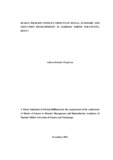| dc.description.abstract | Previous years have seen an increase in resources channeled in an effort to manage conflicts in the wildlife sector. Kenya Wildlife Service has invested heavily in implementation of strategies as a concerted effort by the government to curb Human Wildlife Conflict in Kenya. Despite this effort, cases of Human Wildlife Conflicts are still being reported. The various existing policies seems not to offer solutions to the prevailing Human Wildlife Conflict. It’s on this foundation that the study sort to assess how human wildlife conflict affect the social, economic and education development in Baringo North Sub-County, Kenya. The specific objectives are: To identify the causes of human wildlife conflict in Baringo North Sub county, to examine the nature and extent of wildlife Conflicts in Baringo North Sub-County, Kenya; evaluate the impacts of human wildlife conflict on socio-economic and education development in Baringo North Sub-County, Kenya; and analyze the effectiveness of emergency response strategies in the management of human wildlife conflict for social, economic and education developments in Baringo North Sub-County, Kenya. The study is significant since its outcome could be used to review the current and existing wildlife conservation policies in order to enhance its effectiveness and to formulate new policies. The study was guided by Stern Theory of Value Belief Norm; Kenneth’s and Kilmann’s Conflict Styles theory and Dollard’s Frustration Aggression Displacement theory. A descriptive survey research design was used. The study population was; Government field officers, Civil society leaders, Kenya Wildlife Service official, Opinion leaders, Teachers, Community based organizations, Leaders of Farmers Corporations, Village elders and victims of human wildlife conflicts, totaling to 329 respondents. Sampling techniques used were simple random sampling, purposive sampling and snowball sampling technique. Data was collected using questionnaires, interview schedules, observation checklist and Focus Group Discussions. Pilot study was done in Rimoi game reserve to determine reliability. Descriptive analysis using quantitative and qualitative techniques were used in the study. While quantitative data was presented in form of frequencies and percentage, in tables, charts and graphs, qualitative data was presented thematically through narratives reports and verbatim quotations. Findings indicated that shared water sources was the main cause of the conflict. That most of the attacks occurred at work/in farms. Crop damage /loss was a major impact of the conflict. The study found that medical treatment, psychotherapy and Compensation were a coping strategies among the victims of conflict. Basing on the study findings, Human Wildlife Conflict negatively impacts on social, economic and education development in Baringo North Sub County. That human encroachment into the reserve has led to loss of biodiversity and therefore, affected economic opportunities that could raise earnings for the community. Study recommends that there is need to address Human Wildlife Conflict to pave way for a realistic social-economic development. Government should resolve Human Wildlife Conflict by generating, lasting solutions like fencing off the reserve to keep off roaming wildlife. Compensation policy should also be simplified for prompt payments. The initial owners of the land in which the reserve covers should also be compensated well to deal with the problem of people encroaching back into the reserved land. The emergencies response strategies need to be looked at afresh; there is need for government Agencies to be proactive in handling and forestalling issues arising from the Human Wildlife Conflict. | en_US |

